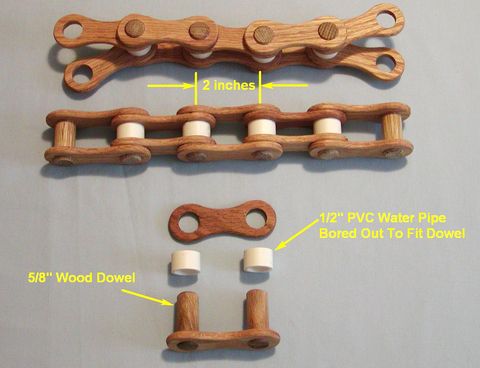
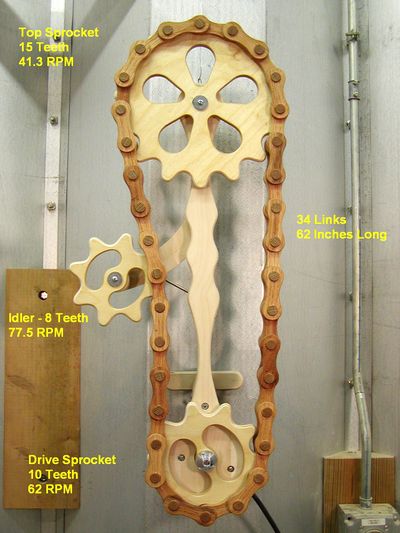
Ronald Walters writes:
I wanted to experiment with making a wood roller chain.
How difficult would it be to make one? How long would it last?
I decided to make the first chain a little on the large size as it would be easier to work with and easier to see any wear points or weaknesses after running it for a while.
The motorized assembly serves no purpose other than running the chain for an extended period of time to see how it holds up.
One of the determining factors for the size was the material available for the roller. I did not want to center drill wood dowel for this purpose, as I did not expect a wood roller would last very long. I found 1/2" PVC water pipe was almost the right size for 5/8" wood dowel. I cut the rollers to the correct length and bored them to the correct inside diameter on my lathe.
The links and pins are oak. I used the wood just as it came off the board, wormholes and all. A drilling jig was used to get the hole spacing exactly the same. I used a sanding jig to round the ends on the disc sander. Internal radius of the links was done by eye on a reciprocating drum sander. A holding jig was used to round over the edges on the router table. An assembly jig was used to glue the pins to one outside link. This assured the pins were square to the outside link.
The outside links are glued to the pins with Titebond Original Wood Glue.
I wanted to use Linseed Oil for the finish. Internal links and surfaces need to be oiled prior to assembly. You need to be careful not to get any oil on the surfaces you are going to glue. After the glue has dried, the linseed oil applied to external surfaces has not appeared to weaken the joints. Avoid getting linseed oil on the internal pin surfaces if possible.
The first 10 hours loosened up the chain. Since then I have noticed no change in the chain itself. After 747 hours running time (560 miles) the links are firm and show no signs of wear. You can see the internal surfaces of the master link look like new. The rollers seem to work well on the sprockets.
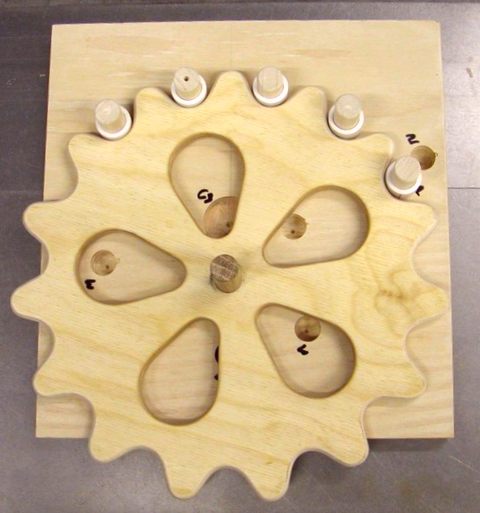
The sprockets need to run true or they will encounter problems with the chain, such as jumping or tightening and loosening as the high and low spots run opposite each other. The chain runs too fast to identify a specific troublesome point on the chain or on a sprocket.
A given point on the chain will match up with a given point on the bottom drive sprocket only once every 5 revolutions of the sprocket. The same point on the chain will only match with a given point on the top larger sprocket once in 15 revolutions. This adds to the difficulty identifying the point(s) causing the chain to jump.
Originally, I thought I would be able to detect wear spots on the sprockets and could adjust them accordingly. The PVC rollers on the chain have proven to work extremely well and I never have detected any significant wear spots.
The sprockets were made by hand. Paper templates, wood grain, the Forstner bits wandering, sanding and rounding-over edges on the router table all contribute to things being less than perfect.
I devised a Go-NoGo gauge to adjust the sprockets, which worked pretty well. The center of the sprocket is pinned with a dowel. The outside pins (with a PVC roller in place) represent the rollers on the chain. Advancing the sprocket one tooth at a time, I looked for tight spots and made necessary adjustments.
I will use a drilling jig for making any future sprockets.
The sprockets are cut from 1/2" Baltic Birch Plywood. The top and idler sprockets run on a 5/8" dowel axle. After 474 hours there is no appreciable wear. The top sprocket axle is oak dowel and the idler sprocket is poplar dowel. The holes in the sprockets are polished. There is no noticeable wear on the axles after 1.175 million revolutions of the top sprocket and 2.2 million revolutions of the idler sprocket.
Wooden roller chain sprockets are relatively straightforwrd to calculate with basic geometry, though the chains have a lot of parts in them. A simpler, older form of chain is a block chain. A tricky part with block chains is that the sprockets can be complex to calculate, though my gear generator can generate block chain sprocket templates
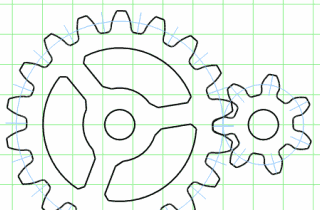
|
You can also design chains and sprockets with the gear generaor |
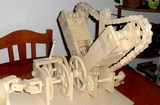 Gábor Németh's Gas engine model
Gábor Németh's Gas engine model